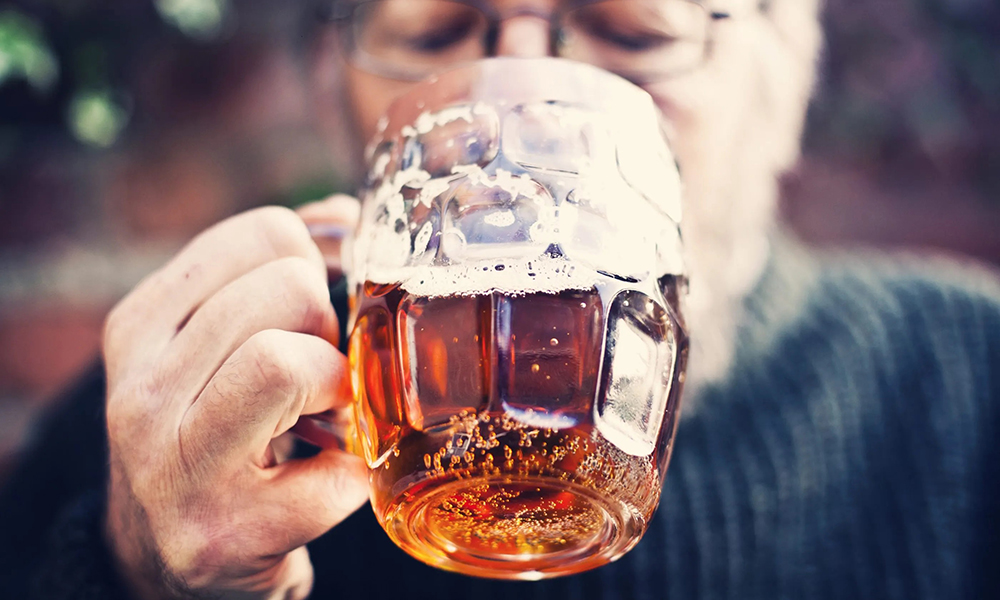
酗酒现象在各年龄段人群中普遍存在,但在某个特定年龄段的人群中,这一不良习惯的增长趋势尤为显著。
长期以来,酗酒常与大学生群体联系在一起,然而,酗酒现象在老年人中呈上升趋势。酗酒的定义是,女性每月饮酒至少五次,而且在两小时内饮用4杯或以上的酒品,男性则为每月饮酒至少五次,而且在两小时内饮用5杯或以上的酒品。根据全美药物使用和健康调查报告,在60岁至64岁的成年人中,有20%的人在最近一个月内报告有酗酒行为。65岁以上人群的酗酒率为12%,这一比例在过去十年中一直在上升,而18至25岁年轻人的酗酒率一直在下降。
这一令人担忧的趋势背后是什么?这可能会改变人们对酒精的看法。
美国国家酒精滥用及酗酒研究所所长乔治·F·库布(George F. Koob)博士说:“老年人酗酒的频率往往高于65岁以下的人群。”他补充说,数据显示,65岁及以上的人群每月至少饮酒20天的比例高于18岁至64岁的人群。
如今,越来越多的年轻人倾向于戒酒。盖洛普(Gallup)的一项调查发现,在18岁至34岁的人群中,65%的人认为饮酒有害健康,而在55岁及以上的人群中,这一比例仅为39%。
虽然目前老年人酗酒的比例有所增加,但预计在未来40年中,这一年龄段的老年人数量将会翻倍。
库布说:“因此,即使老年人酗酒的比例保持不变,老年人酗酒的绝对数量也会继续快速增长,这可能会给我们的医疗保健系统带来越来越大的负担。”
酗酒对老年人有什么危害?
对于老年人来说,酒精的影响会加剧。随着年龄的增长,人体保持水分的能力逐渐减弱,因此老年人会更快地感受到酒精的影响。库布说,老年人代谢酒精的机制也不同。
库布说:“随着年龄的增长,我们的身体会发生变化,这些变化使得我们对饮酒带来的潜在危害更加敏感。与年轻饮酒者相比,老年饮酒者在执行某些任务时的表现往往不尽如人意,包括驾驶能力、反应时间、记忆力和平衡力。”
此外,即使不喝酒,老年人也更容易出现平衡问题,并且容易摔倒(对于65岁及以上的人群来说,摔倒是导致受伤的主要原因)。
库布说:“研究表明,醉酒时摔倒造成的伤害往往比不饮酒时摔倒造成的伤害更为严重。”美国疾病控制与预防中心(CDC)估计,近40%的跌倒与酒精有关,且血液中酒精浓度至少为0.10%。
老年人也更有可能同时服用多种药物,包括睡眠药物和其他药物,这些药物与酒精同时服用可能会造成危险。
长期酗酒会增加罹患酒精使用障碍、某些癌症、心脏病和精神疾病的风险。
以下是一些有助于评估您饮酒习惯的问题
识别各个年龄段人群酗酒的迹象都颇具挑战,尤其是对于老年人而言。
他说:“老年饮酒者可能已经退休,独居,社交活动较少。因此,他们的饮酒行为对工作出勤率或学习成绩等传统指标的影响可能较小。"
密西根酒精依赖简易筛查量表-老年版(SMAST-G)是一项帮助评估老年人饮酒习惯的调查。以下是其中的一些问题:
•与他人交谈时,你是否曾低估自己的酒量?
•喝了几杯酒后,你是否有时会因为不觉得饿而不吃或少吃一顿饭?
•喝几杯酒是否有助于减轻你的颤抖或震颤?
•饮酒是否有时会让你难以回忆起白天或晚上发生的一些事情?
•医生或护士是否曾对你的饮酒习惯表示担心或忧虑?
•你是否曾制定规则来控制饮酒?
•当你感到孤独时,饮酒是否对你有所帮助?(财富中文网)
译者:中慧言-王芳
酗酒现象在各年龄段人群中普遍存在,但在某个特定年龄段的人群中,这一不良习惯的增长趋势尤为显著。
长期以来,酗酒常与大学生群体联系在一起,然而,酗酒现象在老年人中呈上升趋势。酗酒的定义是,女性每月饮酒至少五次,而且在两小时内饮用4杯或以上的酒品,男性则为每月饮酒至少五次,而且在两小时内饮用5杯或以上的酒品。根据全美药物使用和健康调查报告,在60岁至64岁的成年人中,有20%的人在最近一个月内报告有酗酒行为。65岁以上人群的酗酒率为12%,这一比例在过去十年中一直在上升,而18至25岁年轻人的酗酒率一直在下降。
这一令人担忧的趋势背后是什么?这可能会改变人们对酒精的看法。
美国国家酒精滥用及酗酒研究所所长乔治·F·库布(George F. Koob)博士说:“老年人酗酒的频率往往高于65岁以下的人群。”他补充说,数据显示,65岁及以上的人群每月至少饮酒20天的比例高于18岁至64岁的人群。
如今,越来越多的年轻人倾向于戒酒。盖洛普(Gallup)的一项调查发现,在18岁至34岁的人群中,65%的人认为饮酒有害健康,而在55岁及以上的人群中,这一比例仅为39%。
虽然目前老年人酗酒的比例有所增加,但预计在未来40年中,这一年龄段的老年人数量将会翻倍。
库布说:“因此,即使老年人酗酒的比例保持不变,老年人酗酒的绝对数量也会继续快速增长,这可能会给我们的医疗保健系统带来越来越大的负担。”
酗酒对老年人有什么危害?
对于老年人来说,酒精的影响会加剧。随着年龄的增长,人体保持水分的能力逐渐减弱,因此老年人会更快地感受到酒精的影响。库布说,老年人代谢酒精的机制也不同。
库布说:“随着年龄的增长,我们的身体会发生变化,这些变化使得我们对饮酒带来的潜在危害更加敏感。与年轻饮酒者相比,老年饮酒者在执行某些任务时的表现往往不尽如人意,包括驾驶能力、反应时间、记忆力和平衡力。”
此外,即使不喝酒,老年人也更容易出现平衡问题,并且容易摔倒(对于65岁及以上的人群来说,摔倒是导致受伤的主要原因)。
库布说:“研究表明,醉酒时摔倒造成的伤害往往比不饮酒时摔倒造成的伤害更为严重。”美国疾病控制与预防中心(CDC)估计,近40%的跌倒与酒精有关,且血液中酒精浓度至少为0.10%。
老年人也更有可能同时服用多种药物,包括睡眠药物和其他药物,这些药物与酒精同时服用可能会造成危险。
长期酗酒会增加罹患酒精使用障碍、某些癌症、心脏病和精神疾病的风险。
以下是一些有助于评估您饮酒习惯的问题
识别各个年龄段人群酗酒的迹象都颇具挑战,尤其是对于老年人而言。
他说:“老年饮酒者可能已经退休,独居,社交活动较少。因此,他们的饮酒行为对工作出勤率或学习成绩等传统指标的影响可能较小。"
密西根酒精依赖简易筛查量表-老年版(SMAST-G)是一项帮助评估老年人饮酒习惯的调查。以下是其中的一些问题:
•与他人交谈时,你是否曾低估自己的酒量?
•喝了几杯酒后,你是否有时会因为不觉得饿而不吃或少吃一顿饭?
•喝几杯酒是否有助于减轻你的颤抖或震颤?
•饮酒是否有时会让你难以回忆起白天或晚上发生的一些事情?
•医生或护士是否曾对你的饮酒习惯表示担心或忧虑?
•你是否曾制定规则来控制饮酒?
•当你感到孤独时,饮酒是否对你有所帮助?(财富中文网)
译者:中慧言-王芳
Binge drinking is prevalent across generations, but the dangerous habit is growing among one age group in particular.
Long associated with college students, binge drinking, defined as having four or more drinks within two hours at least five times per month for women (five drinks for men) is on the rise among older adults. According to The National Survey on Drug Use and Health, 20% of adults aged 60 to 64, reported binge drinking in the last month. For those older than 65, the prevalence of binge drinking is 12%—a rate that has been increasing over the last decade, while binge drinking rates among young adults 18 to 25 have been going down.
What’s behind the concerning trend? It may be changing views on alcohol.
“Older adults who drink do so more frequently than people under 65,” says George F. Koob, PhD, director of the National Institute on Alcohol Abuse and Alcoholism, adding that the data shows a larger percentage of those 65 and older drink 20 or more days a month compared to those 18 to 64.
Today’s young adults are increasingly embracing sobriety. One Gallup survey found that 65% of 18 to 34-year-olds say alcohol is bad for your health compared to 39% of those 55 and older.
While the percentage of older adults who are binge drinkers has increased slightly, the growing number of older adults who are in this age group will double in the next 40 years.
“As a result, even if the percentage of older adults who binge remained the same, the sheer number of older adult binge drinkers would continue to grow rapidly, potentially placing an increasing burden on our healthcare system,” Koob says.
What are the dangers of binge drinking for older adults?
For older adults, alcohol’s effects are intensified. The body’s ability to retain water decreases with age, so older adults feel the effects of alcohol faster. Older adults also metabolize alcohol differently, Koob says.
“The body changes as we age and these changes render us more susceptible to some of the harms that stem from alcohol use,” Koob says. “Older drinkers show bigger impairments than younger drinkers on some tasks, including driving performance, reaction time, memory, and balance.”
Moreover, older adults are more likely to struggle with balance and experience falls even without alcohol (Falling is the leading cause of injury for those 65 and older).
“Studies suggest the injuries sustained from falls while intoxicated tend to be more severe than injuries from falls that do not involve alcohol,” Koob says. The U.S. Centers for Disease Control and Prevention (CDC) estimates that nearly 40% of falls involve alcohol and at least a blood alcohol concentration of 0.10%.
Older adults are also more likely to be on several medications, including sleep medications and other drugs, which may be dangerous when taken in combination with alcohol.
Long term binge drinking can increase the risk of alcohol use disorder, certain cancers, heart disease, and mental health disorders.
Questions to help assess your alcohol habits
Symptoms of binge drinking can be hard to decipher, especially for older adults.
“Older drinkers might be retired, live alone, and socialize less. As a result, their drinking might have less of an impact on things like work attendance or school performance,” he says.
The Short Michigan Alcoholism Screening Test–Geriatric Version (SMAST-G) is one survey to help assess older adults’ drinking habits. Here are some of the questions:
• When talking with others, do you ever underestimate how much you drink?
• After a few drinks, have you sometimes not eaten or been able to skip a meal because you didn’t feel hungry?
• Does having a few drinks help decrease your shakiness or tremors?
• Does alcohol sometimes make it hard for you to remember parts of the day or night?
• Has a doctor or nurse ever said they were worried or concerned about your drinking?
• Have you ever made rules to manage your drinking?
• When you feel lonely, does having a drink help?






